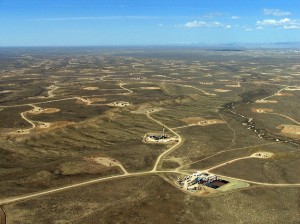Report on Air Sampling in Alabama
January 15, 2007Disposable workers of the oil and gas fields
April 2, 2007
After working for 15 years as an exploration consultant to the oil-and-gas industry, using satellite imagery to hunt for likely drilling sites, John Amos had a road-to-Damascus moment when he viewed satellite imagery of wells in the Jonah natural gas field, in Wyoming’s Upper Green River Valley.
“I started seeing stuff on the satellite imagery that didn’t square with the things I was hearing either from industry or from the federal agencies responsible for managing those lands,” recalls Amos. “It seemed strange to me that a consultant in the industry wouldn’t know these things were going on.”
Both the extent and the impact of oil-and-gas production in the Rocky Mountain West, Amos realized, were far larger than the energy industry or the federal agencies were letting on. That discovery led him to found SkyTruth, a high-tech environmental outfit based in Amos’ home in Shepherdstown, West Virginia and dedicated to collecting and disseminating satellite imagery that documents the effects of mining and drilling activities around the world.
Awarded non-profit status in 2002, SkyTruth collects raw digital data from public domain sources like the U.S Geological Survey and NASA as well as Google Earth, then processes it into images, maps and graphics that document the landscape impacts of extractive industries including oil and natural-gas drilling, commercial fishing, and mining. Portrayed on SkyTruth’s Web site in vivid, sequential color shots taken over a period of years, the images demonstrate conclusively that, when it comes to resource extraction, what we are told often doesn’t jibe with what’s actually going on.
“These are public resources, and the public should have a say in how they’re managed,” Amos points out. “I think the public is being kindof misled. The technology exists to show people what’s happening to these places, and let them see it with their own eyes. To give them a first-hand experience to understand what’s really happening.”
Amos is among a small cadre of tech-savvy green activists, many of whom got their start in the energy or info-tech businesses, who are changing the terms of the argument over appropriate use of public lands.
Google Earth, Amos says, has “revolutionized environmental communications.”
Included on the site are environmental disasters as far afield as Irian Jaya, where the Denver-based Freeport McMoran mining concern has deposited gold-mine tailings across huge swathes of the lowland forests along rivers, and the Yanacocha gold and copper mine in Peru. Most of these areas are so remote that few people other than company employees — and the locals, who are usually powerless to control what goes on in their homelands — will ever see them.
Early in January the 10-min. video of drilling in western Wyoming, including the Upper Green, went up on YouTube and is generating new attention for SkyTruth and the wealth of photographic documentation now available online. The first BLM environmental-impact statement for the Jonah Field estimated that no more than 500 wells would be drilled to remove all the accessible gas, over 15 years. Within less than five years, according to SkyTruth, there were more than 500 drilled, and the industry sought and won permits last year for another 3100.
The BLM has also released a plan to increase the number of wells on the neighboring Pinedale Anticline field, currently permitted for 700 sites, to 4400. The public-comment period on that plan is now open, and it closes on Feb. 13.


